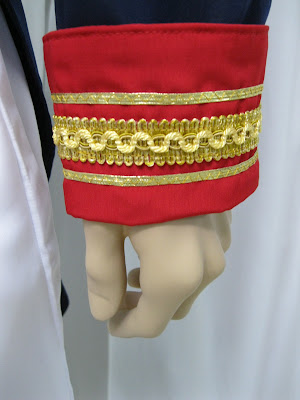The past few months here in the studio have been chock full of the Forgotten War. As we've mentioned previously, we were updating costumes for two currently running programs with the White House Historical Association:
First Kids, about kids who have lived in the White House over the course of our country's history, and
Paths to Freedom, about the Civil War (check out the video on their website to see a sampling of the costumes we made for them!)
 |
| Welcome to the chaos! |
The third program was to be
completely new, about the War of 1812. We made costumes for an entire cast of characters: President James and First Lady Dolley Madison, Dolley's house servant Sukey, the 15 year old slave Paul Jennings who helped save the famous painting of George Washington, and the French Ambassador Louis Serurier, among many many others that we will detail in an upcoming post.
 |
| The List |
 |
| In the beginning... there was fabric |
For this post we will simply detail the PROCESS. And process it was. From design and conception to patterning to full-scale factory-style assembly line, we were in full tilt for the entirety of the project. The complexity of the costumes, particularly of the men's uniform jackets, was daunting. Men's coats in 1812, especially those of the military and upper class, had all the trimmings: cuffs, tails, standing collars, layers of interfacing, and buttons galore.
We were all hands on deck so Caroline (who you may remember from
this post about LADEC) and Barb, two lovely ladies we have worked with in the past, came back to join the fun and frenzy. We were also joined by our new regular addition, Sara (who you may remember from our recent
Halloween post.) And as always, Marilyn, Meghan and I were there in the thick of it.
 |
| Caroline and the impressive pile o' trims |
 |
| Barb, about to start buttoning |
 |
Sara and Meghan sewing and serging
 |
Me carefully labeling and cutting jackets so as not to lose them in the flurry of blue peachskin faille
|
 |
Sara, Marilyn, Meghan, and Caroline were positioned perfectly long enough
for me to snap one picture, and then it was back to the 1812 flurry!
|
All the costumes were made from a hue of peachskin faille, an extremely sturdy polyester blend that has the look of a more expensive fabric, hangs well, doesn't fade with wash or wear, and is virtually un-wrinkleable. In other words, perfect for costumes that literally thousands of kids will be pulling on and off over their clothes over the course of the next several years. With our 1812 order we also had some minor repairs to do on some of the Civil War and First Kids jackets from several years ago, and even we were impressed at how well the costumes had stood the test of time: the fabric on a brand new jacket and a six year old jacket needing button repairs were virtually identical.
|
 |
| All machines on deck! |
 |
| An overflowing bucket o' ladies-to-be |
When we first began this project, we knew we were going to need a little extra something to unite us in focus and drive, and to help any extra-long days feel not so extra-long. Enter: Harry Potter. We listened to the entire seven book series while we cut, serged, stitched, and pressed. 117 hours and 4 minutes of Jim Dale interpreting J.K. Rowling. It was by far our best decision, and to be quite honest we feel a little lost without them now (is it too soon to start all over??)
 |
Oh Harry Potter. We laughed with you, we cried with you.
Mainly cried though, because holy moly what a sad series. |
And then, suddenly, we were done. We stood back for only a moment to admire our handiwork before moving into the next project, but that moment felt GOOD.
 |
| All the laydees |
 |
| The finished rack! The costumes wrapped all the way around. |
 |
| Meghan gets pictures of her cravat handiwork. Note Marilyn in the loft holding them all up. |
And then it was time for the costumes to go to their new home in DC, but not before one last photo op! Note the two newest members of the nonmoving branch of our studio family, Trevor and Susie Q. They fit in very nicely with Molly and our other two dress forms, don't you think?
 |
| Photo credit: White House Historical Association @WhiteHouseHstry |
Last, but most certainly not least, thank you so much to John, Courtney, Katie, and the ladies and gents of the White House Historical Association for the opportunity to work with you again. This project was exciting and colorful and stretched us creatively and mentally in so many wonderful ways we never expected. We learned some history, drafted some patterns, and invented whole new ways of interpreting historical research to fit the unique needs of this program. We got to do what we love and we are so happy with the result, and even happier that you love it too.
















































